Business Law Report: English Legal System and Employer's Obligations
VerifiedAdded on 2020/07/23
|15
|4857
|52
Report
AI Summary
This report provides a comprehensive overview of key aspects of business law. It begins with an introduction to the English legal system, exploring its structure and various sources of law, including legislation, case law, EU legislations, and customs. The report then delves into the role of the government in establishing and implementing laws, detailing the stages involved in the parliamentary process. Furthermore, the report examines employer's legal obligations, focusing on occupational health and safety, workers' compensation, and harassment protection, supported by relevant case law. The report also covers the concept and benefits of alternative dispute resolution processes, offering appropriate legal solutions. The report includes an analysis of the legal framework, providing valuable insights into business law principles and practical applications. The content is contributed by a student and published on Desklib, a platform offering AI-based study tools for students.
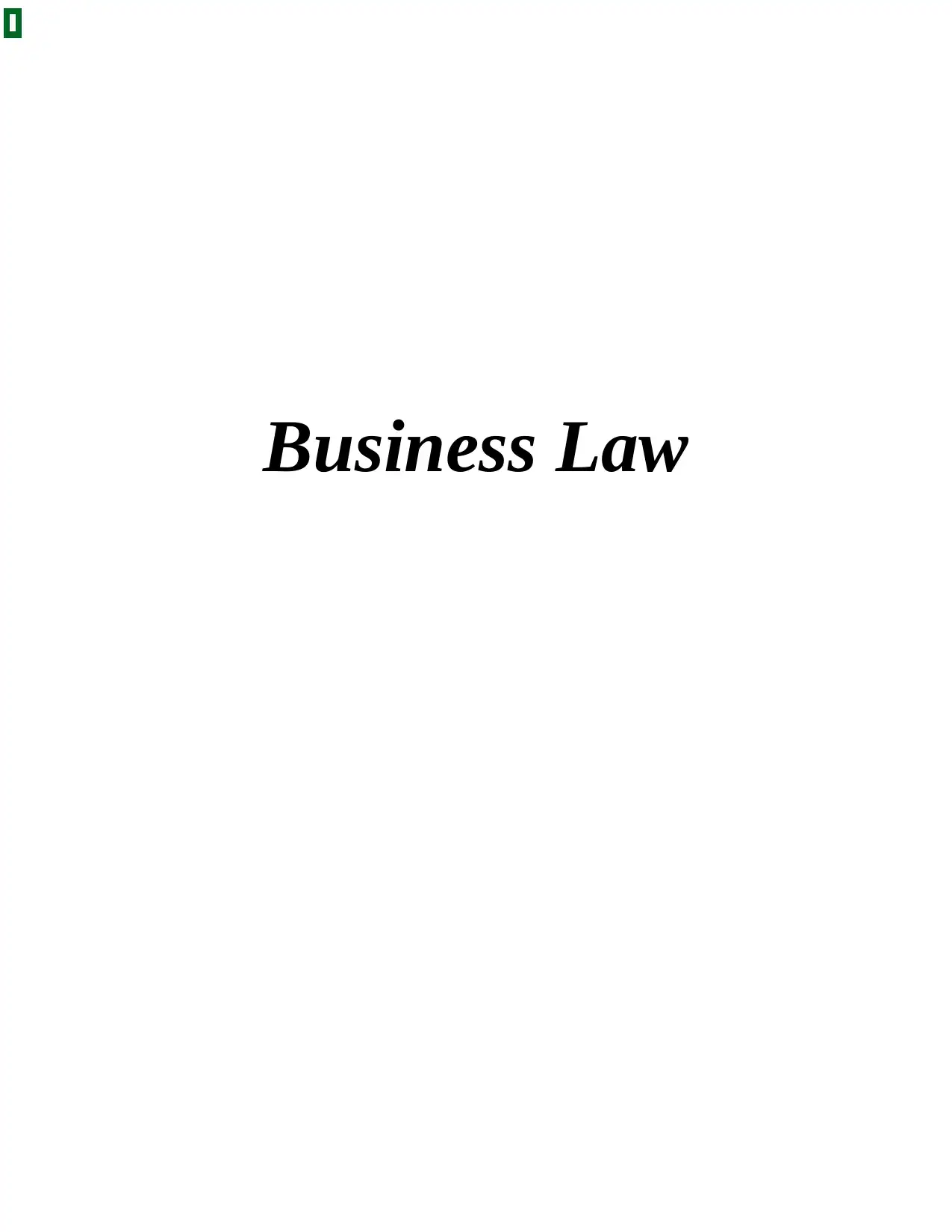
Business Law
Paraphrase This Document
Need a fresh take? Get an instant paraphrase of this document with our AI Paraphraser
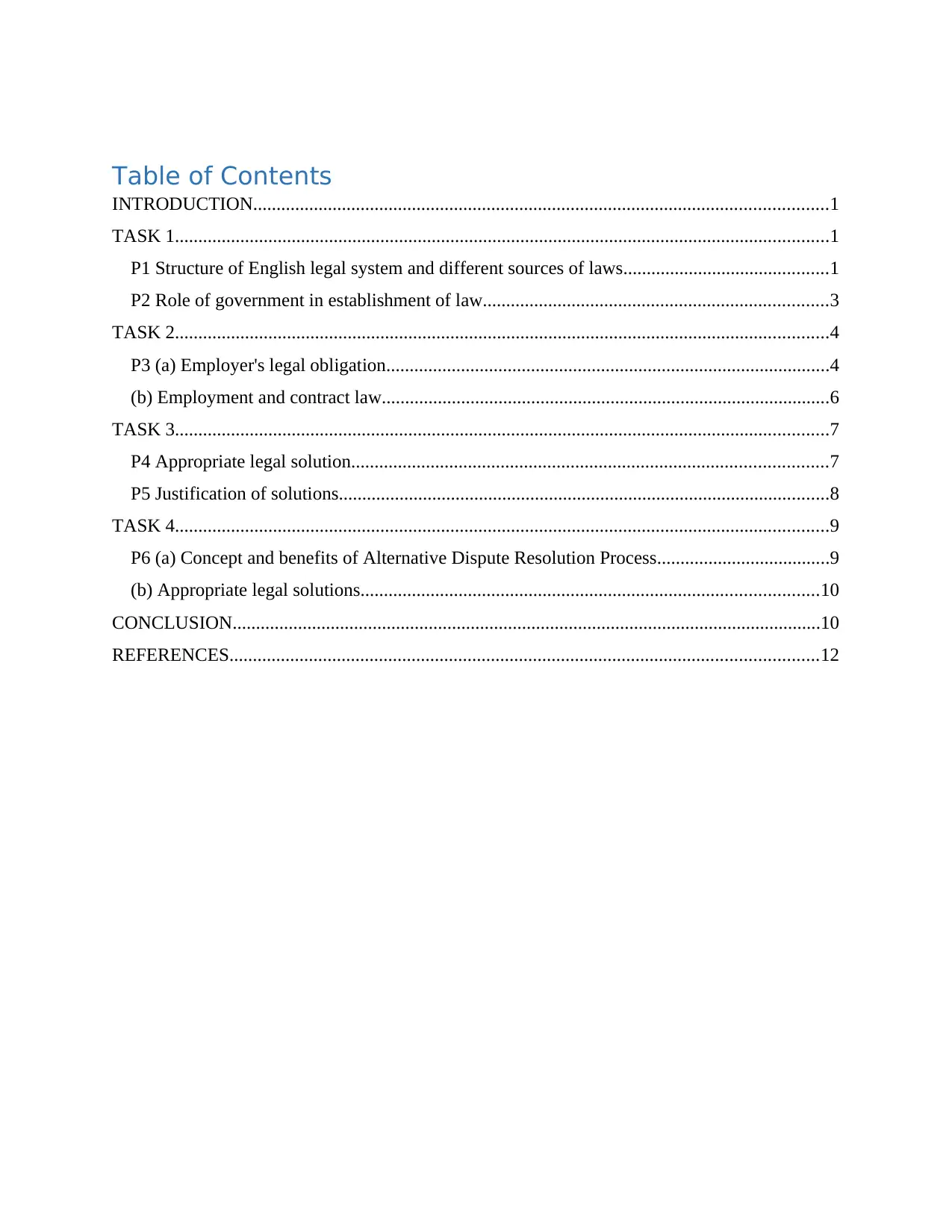
Table of Contents
INTRODUCTION...........................................................................................................................1
TASK 1............................................................................................................................................1
P1 Structure of English legal system and different sources of laws............................................1
P2 Role of government in establishment of law..........................................................................3
TASK 2............................................................................................................................................4
P3 (a) Employer's legal obligation...............................................................................................4
(b) Employment and contract law................................................................................................6
TASK 3............................................................................................................................................7
P4 Appropriate legal solution......................................................................................................7
P5 Justification of solutions.........................................................................................................8
TASK 4............................................................................................................................................9
P6 (a) Concept and benefits of Alternative Dispute Resolution Process.....................................9
(b) Appropriate legal solutions..................................................................................................10
CONCLUSION..............................................................................................................................10
REFERENCES..............................................................................................................................12
INTRODUCTION...........................................................................................................................1
TASK 1............................................................................................................................................1
P1 Structure of English legal system and different sources of laws............................................1
P2 Role of government in establishment of law..........................................................................3
TASK 2............................................................................................................................................4
P3 (a) Employer's legal obligation...............................................................................................4
(b) Employment and contract law................................................................................................6
TASK 3............................................................................................................................................7
P4 Appropriate legal solution......................................................................................................7
P5 Justification of solutions.........................................................................................................8
TASK 4............................................................................................................................................9
P6 (a) Concept and benefits of Alternative Dispute Resolution Process.....................................9
(b) Appropriate legal solutions..................................................................................................10
CONCLUSION..............................................................................................................................10
REFERENCES..............................................................................................................................12
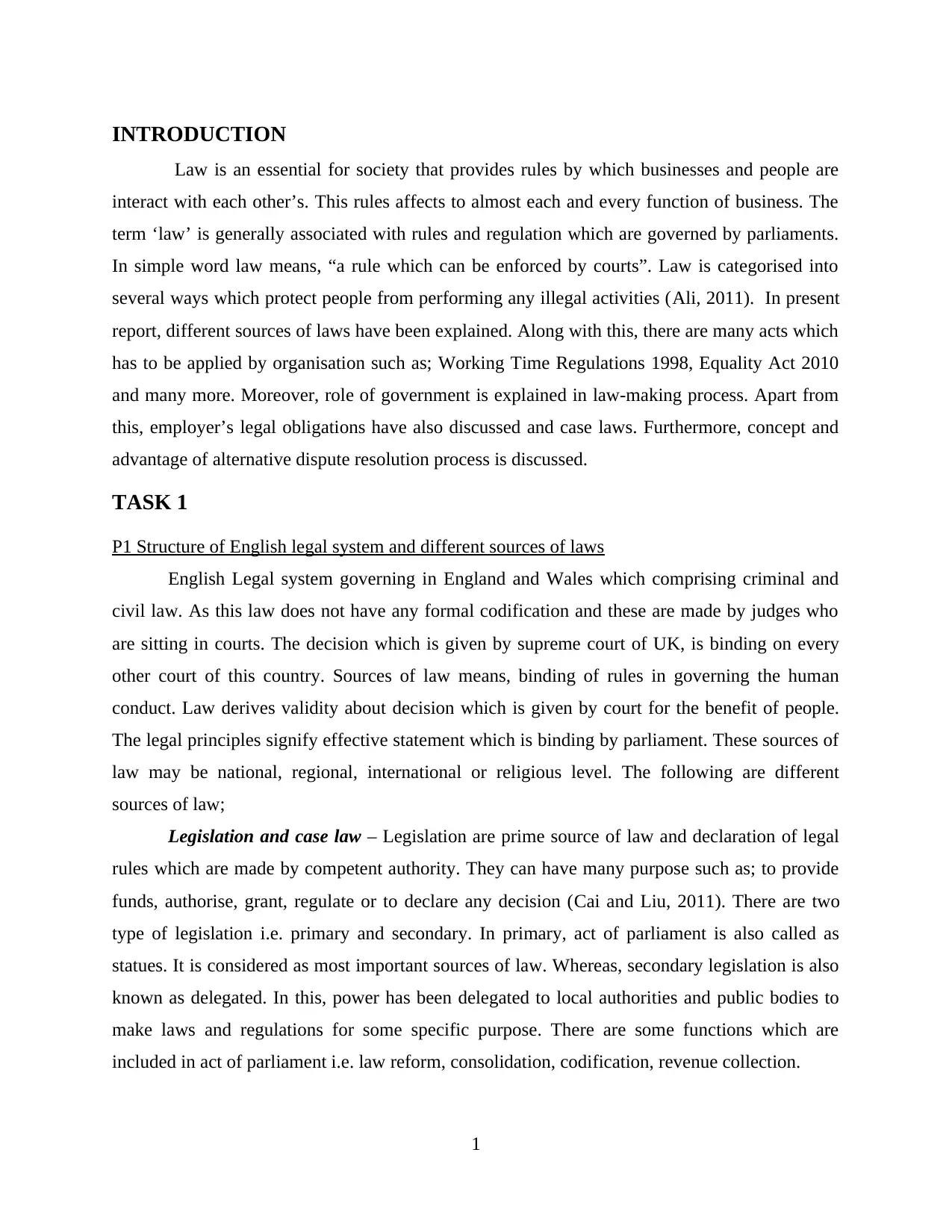
INTRODUCTION
Law is an essential for society that provides rules by which businesses and people are
interact with each other’s. This rules affects to almost each and every function of business. The
term ‘law’ is generally associated with rules and regulation which are governed by parliaments.
In simple word law means, “a rule which can be enforced by courts”. Law is categorised into
several ways which protect people from performing any illegal activities (Ali, 2011). In present
report, different sources of laws have been explained. Along with this, there are many acts which
has to be applied by organisation such as; Working Time Regulations 1998, Equality Act 2010
and many more. Moreover, role of government is explained in law-making process. Apart from
this, employer’s legal obligations have also discussed and case laws. Furthermore, concept and
advantage of alternative dispute resolution process is discussed.
TASK 1
P1 Structure of English legal system and different sources of laws
English Legal system governing in England and Wales which comprising criminal and
civil law. As this law does not have any formal codification and these are made by judges who
are sitting in courts. The decision which is given by supreme court of UK, is binding on every
other court of this country. Sources of law means, binding of rules in governing the human
conduct. Law derives validity about decision which is given by court for the benefit of people.
The legal principles signify effective statement which is binding by parliament. These sources of
law may be national, regional, international or religious level. The following are different
sources of law;
Legislation and case law – Legislation are prime source of law and declaration of legal
rules which are made by competent authority. They can have many purpose such as; to provide
funds, authorise, grant, regulate or to declare any decision (Cai and Liu, 2011). There are two
type of legislation i.e. primary and secondary. In primary, act of parliament is also called as
statues. It is considered as most important sources of law. Whereas, secondary legislation is also
known as delegated. In this, power has been delegated to local authorities and public bodies to
make laws and regulations for some specific purpose. There are some functions which are
included in act of parliament i.e. law reform, consolidation, codification, revenue collection.
1
Law is an essential for society that provides rules by which businesses and people are
interact with each other’s. This rules affects to almost each and every function of business. The
term ‘law’ is generally associated with rules and regulation which are governed by parliaments.
In simple word law means, “a rule which can be enforced by courts”. Law is categorised into
several ways which protect people from performing any illegal activities (Ali, 2011). In present
report, different sources of laws have been explained. Along with this, there are many acts which
has to be applied by organisation such as; Working Time Regulations 1998, Equality Act 2010
and many more. Moreover, role of government is explained in law-making process. Apart from
this, employer’s legal obligations have also discussed and case laws. Furthermore, concept and
advantage of alternative dispute resolution process is discussed.
TASK 1
P1 Structure of English legal system and different sources of laws
English Legal system governing in England and Wales which comprising criminal and
civil law. As this law does not have any formal codification and these are made by judges who
are sitting in courts. The decision which is given by supreme court of UK, is binding on every
other court of this country. Sources of law means, binding of rules in governing the human
conduct. Law derives validity about decision which is given by court for the benefit of people.
The legal principles signify effective statement which is binding by parliament. These sources of
law may be national, regional, international or religious level. The following are different
sources of law;
Legislation and case law – Legislation are prime source of law and declaration of legal
rules which are made by competent authority. They can have many purpose such as; to provide
funds, authorise, grant, regulate or to declare any decision (Cai and Liu, 2011). There are two
type of legislation i.e. primary and secondary. In primary, act of parliament is also called as
statues. It is considered as most important sources of law. Whereas, secondary legislation is also
known as delegated. In this, power has been delegated to local authorities and public bodies to
make laws and regulations for some specific purpose. There are some functions which are
included in act of parliament i.e. law reform, consolidation, codification, revenue collection.
1
⊘ This is a preview!⊘
Do you want full access?
Subscribe today to unlock all pages.

Trusted by 1+ million students worldwide
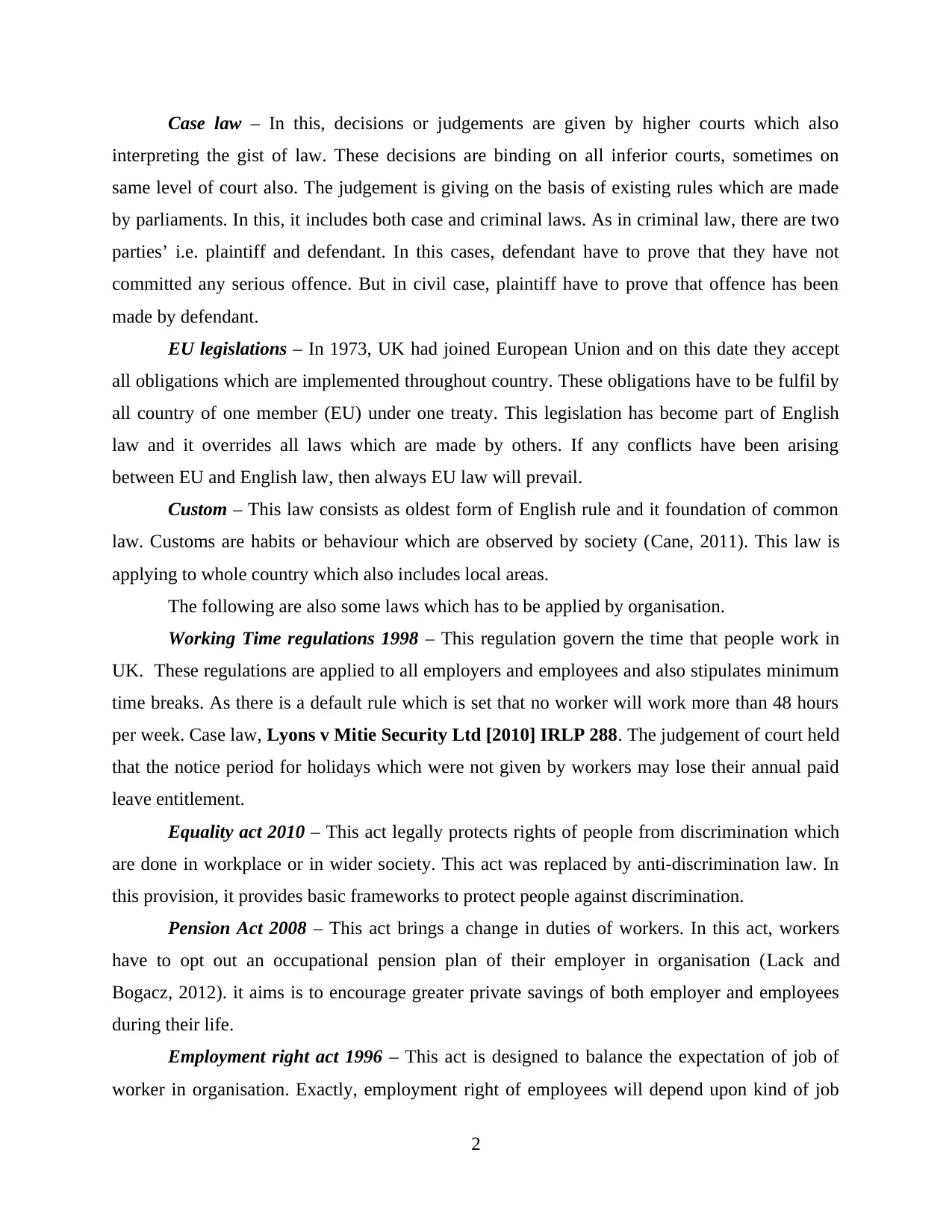
Case law – In this, decisions or judgements are given by higher courts which also
interpreting the gist of law. These decisions are binding on all inferior courts, sometimes on
same level of court also. The judgement is giving on the basis of existing rules which are made
by parliaments. In this, it includes both case and criminal laws. As in criminal law, there are two
parties’ i.e. plaintiff and defendant. In this cases, defendant have to prove that they have not
committed any serious offence. But in civil case, plaintiff have to prove that offence has been
made by defendant.
EU legislations – In 1973, UK had joined European Union and on this date they accept
all obligations which are implemented throughout country. These obligations have to be fulfil by
all country of one member (EU) under one treaty. This legislation has become part of English
law and it overrides all laws which are made by others. If any conflicts have been arising
between EU and English law, then always EU law will prevail.
Custom – This law consists as oldest form of English rule and it foundation of common
law. Customs are habits or behaviour which are observed by society (Cane, 2011). This law is
applying to whole country which also includes local areas.
The following are also some laws which has to be applied by organisation.
Working Time regulations 1998 – This regulation govern the time that people work in
UK. These regulations are applied to all employers and employees and also stipulates minimum
time breaks. As there is a default rule which is set that no worker will work more than 48 hours
per week. Case law, Lyons v Mitie Security Ltd [2010] IRLP 288. The judgement of court held
that the notice period for holidays which were not given by workers may lose their annual paid
leave entitlement.
Equality act 2010 – This act legally protects rights of people from discrimination which
are done in workplace or in wider society. This act was replaced by anti-discrimination law. In
this provision, it provides basic frameworks to protect people against discrimination.
Pension Act 2008 – This act brings a change in duties of workers. In this act, workers
have to opt out an occupational pension plan of their employer in organisation (Lack and
Bogacz, 2012). it aims is to encourage greater private savings of both employer and employees
during their life.
Employment right act 1996 – This act is designed to balance the expectation of job of
worker in organisation. Exactly, employment right of employees will depend upon kind of job
2
interpreting the gist of law. These decisions are binding on all inferior courts, sometimes on
same level of court also. The judgement is giving on the basis of existing rules which are made
by parliaments. In this, it includes both case and criminal laws. As in criminal law, there are two
parties’ i.e. plaintiff and defendant. In this cases, defendant have to prove that they have not
committed any serious offence. But in civil case, plaintiff have to prove that offence has been
made by defendant.
EU legislations – In 1973, UK had joined European Union and on this date they accept
all obligations which are implemented throughout country. These obligations have to be fulfil by
all country of one member (EU) under one treaty. This legislation has become part of English
law and it overrides all laws which are made by others. If any conflicts have been arising
between EU and English law, then always EU law will prevail.
Custom – This law consists as oldest form of English rule and it foundation of common
law. Customs are habits or behaviour which are observed by society (Cane, 2011). This law is
applying to whole country which also includes local areas.
The following are also some laws which has to be applied by organisation.
Working Time regulations 1998 – This regulation govern the time that people work in
UK. These regulations are applied to all employers and employees and also stipulates minimum
time breaks. As there is a default rule which is set that no worker will work more than 48 hours
per week. Case law, Lyons v Mitie Security Ltd [2010] IRLP 288. The judgement of court held
that the notice period for holidays which were not given by workers may lose their annual paid
leave entitlement.
Equality act 2010 – This act legally protects rights of people from discrimination which
are done in workplace or in wider society. This act was replaced by anti-discrimination law. In
this provision, it provides basic frameworks to protect people against discrimination.
Pension Act 2008 – This act brings a change in duties of workers. In this act, workers
have to opt out an occupational pension plan of their employer in organisation (Lack and
Bogacz, 2012). it aims is to encourage greater private savings of both employer and employees
during their life.
Employment right act 1996 – This act is designed to balance the expectation of job of
worker in organisation. Exactly, employment right of employees will depend upon kind of job
2
Paraphrase This Document
Need a fresh take? Get an instant paraphrase of this document with our AI Paraphraser
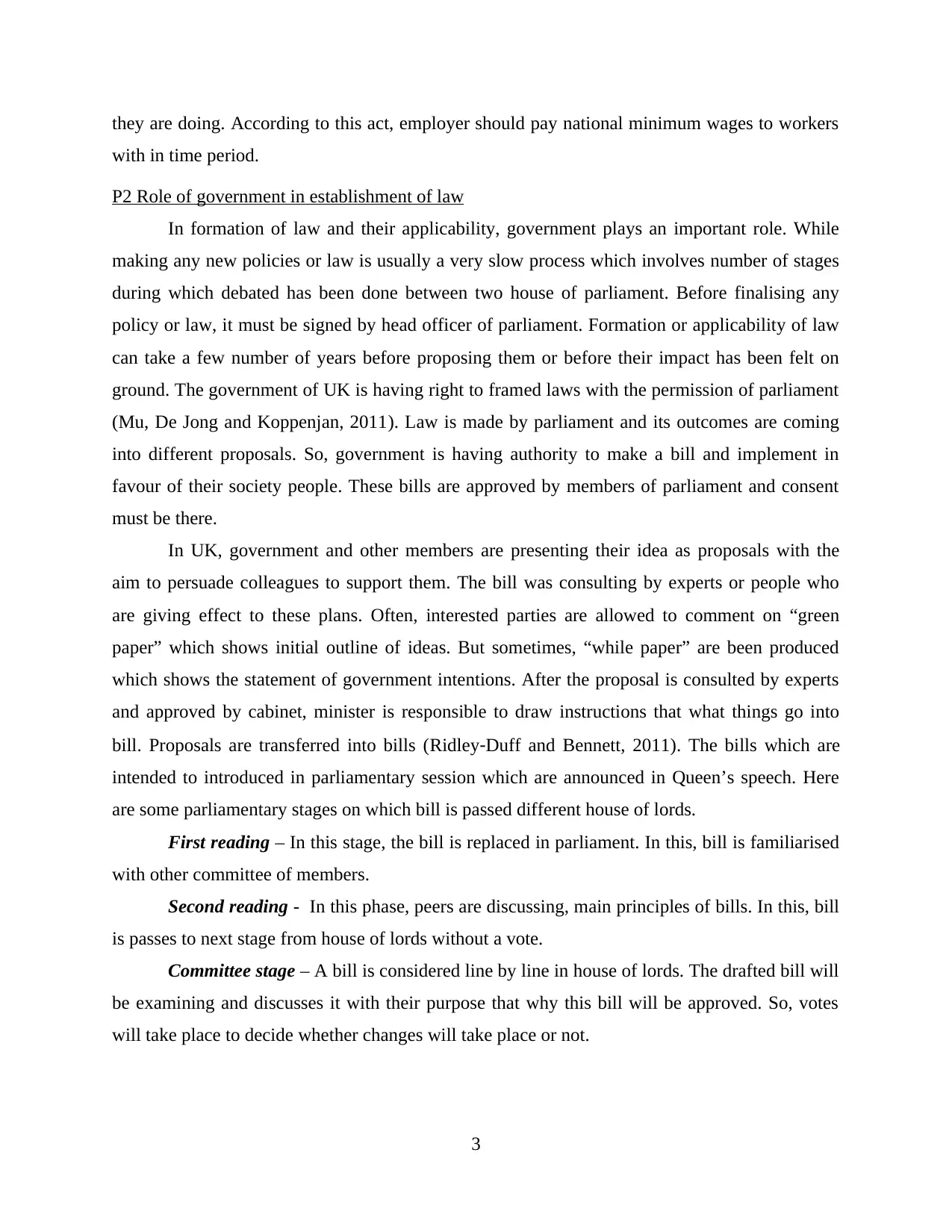
they are doing. According to this act, employer should pay national minimum wages to workers
with in time period.
P2 Role of government in establishment of law
In formation of law and their applicability, government plays an important role. While
making any new policies or law is usually a very slow process which involves number of stages
during which debated has been done between two house of parliament. Before finalising any
policy or law, it must be signed by head officer of parliament. Formation or applicability of law
can take a few number of years before proposing them or before their impact has been felt on
ground. The government of UK is having right to framed laws with the permission of parliament
(Mu, De Jong and Koppenjan, 2011). Law is made by parliament and its outcomes are coming
into different proposals. So, government is having authority to make a bill and implement in
favour of their society people. These bills are approved by members of parliament and consent
must be there.
In UK, government and other members are presenting their idea as proposals with the
aim to persuade colleagues to support them. The bill was consulting by experts or people who
are giving effect to these plans. Often, interested parties are allowed to comment on “green
paper” which shows initial outline of ideas. But sometimes, “while paper” are been produced
which shows the statement of government intentions. After the proposal is consulted by experts
and approved by cabinet, minister is responsible to draw instructions that what things go into
bill. Proposals are transferred into bills (Ridley‐Duff and Bennett, 2011). The bills which are
intended to introduced in parliamentary session which are announced in Queen’s speech. Here
are some parliamentary stages on which bill is passed different house of lords.
First reading – In this stage, the bill is replaced in parliament. In this, bill is familiarised
with other committee of members.
Second reading - In this phase, peers are discussing, main principles of bills. In this, bill
is passes to next stage from house of lords without a vote.
Committee stage – A bill is considered line by line in house of lords. The drafted bill will
be examining and discusses it with their purpose that why this bill will be approved. So, votes
will take place to decide whether changes will take place or not.
3
with in time period.
P2 Role of government in establishment of law
In formation of law and their applicability, government plays an important role. While
making any new policies or law is usually a very slow process which involves number of stages
during which debated has been done between two house of parliament. Before finalising any
policy or law, it must be signed by head officer of parliament. Formation or applicability of law
can take a few number of years before proposing them or before their impact has been felt on
ground. The government of UK is having right to framed laws with the permission of parliament
(Mu, De Jong and Koppenjan, 2011). Law is made by parliament and its outcomes are coming
into different proposals. So, government is having authority to make a bill and implement in
favour of their society people. These bills are approved by members of parliament and consent
must be there.
In UK, government and other members are presenting their idea as proposals with the
aim to persuade colleagues to support them. The bill was consulting by experts or people who
are giving effect to these plans. Often, interested parties are allowed to comment on “green
paper” which shows initial outline of ideas. But sometimes, “while paper” are been produced
which shows the statement of government intentions. After the proposal is consulted by experts
and approved by cabinet, minister is responsible to draw instructions that what things go into
bill. Proposals are transferred into bills (Ridley‐Duff and Bennett, 2011). The bills which are
intended to introduced in parliamentary session which are announced in Queen’s speech. Here
are some parliamentary stages on which bill is passed different house of lords.
First reading – In this stage, the bill is replaced in parliament. In this, bill is familiarised
with other committee of members.
Second reading - In this phase, peers are discussing, main principles of bills. In this, bill
is passes to next stage from house of lords without a vote.
Committee stage – A bill is considered line by line in house of lords. The drafted bill will
be examining and discusses it with their purpose that why this bill will be approved. So, votes
will take place to decide whether changes will take place or not.
3
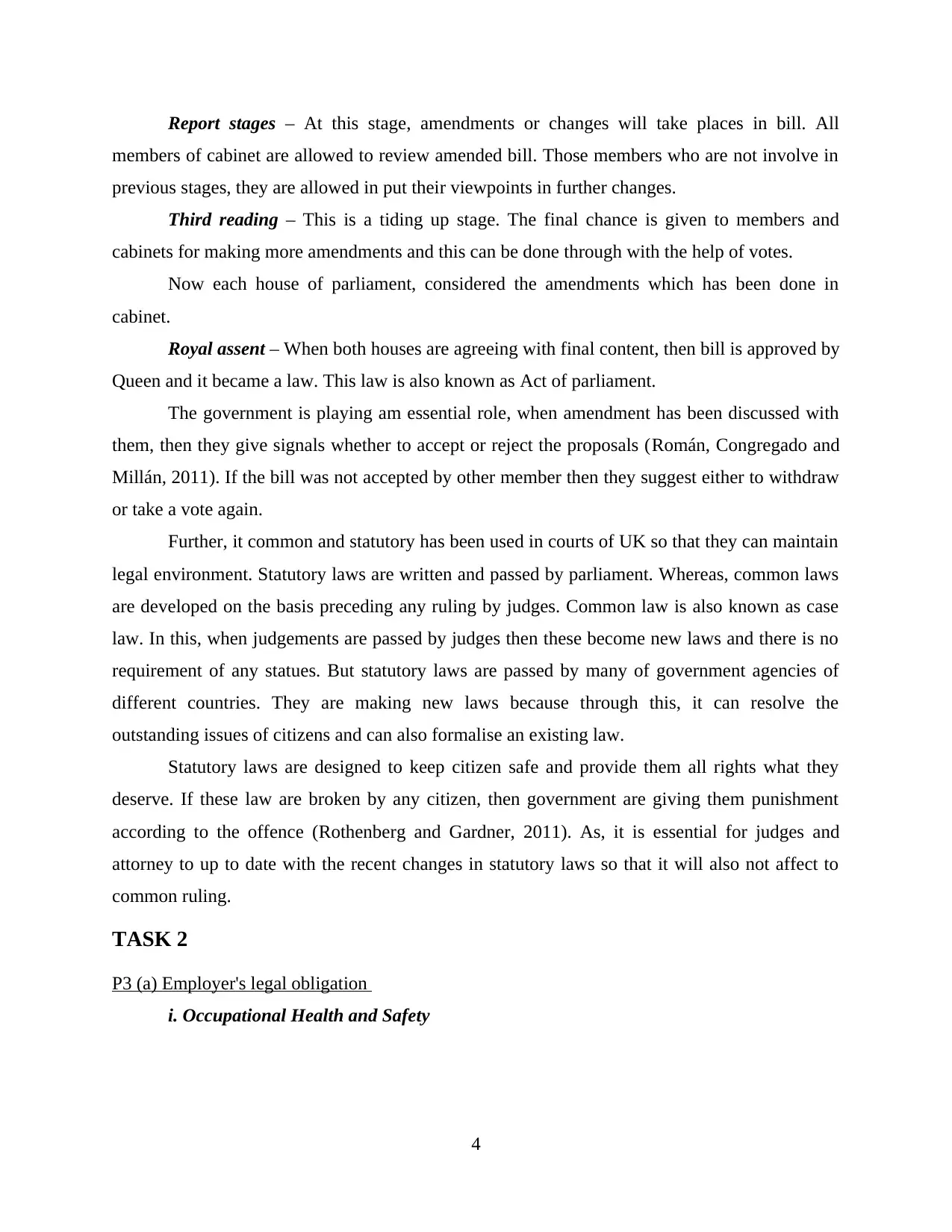
Report stages – At this stage, amendments or changes will take places in bill. All
members of cabinet are allowed to review amended bill. Those members who are not involve in
previous stages, they are allowed in put their viewpoints in further changes.
Third reading – This is a tiding up stage. The final chance is given to members and
cabinets for making more amendments and this can be done through with the help of votes.
Now each house of parliament, considered the amendments which has been done in
cabinet.
Royal assent – When both houses are agreeing with final content, then bill is approved by
Queen and it became a law. This law is also known as Act of parliament.
The government is playing am essential role, when amendment has been discussed with
them, then they give signals whether to accept or reject the proposals (Román, Congregado and
Millán, 2011). If the bill was not accepted by other member then they suggest either to withdraw
or take a vote again.
Further, it common and statutory has been used in courts of UK so that they can maintain
legal environment. Statutory laws are written and passed by parliament. Whereas, common laws
are developed on the basis preceding any ruling by judges. Common law is also known as case
law. In this, when judgements are passed by judges then these become new laws and there is no
requirement of any statues. But statutory laws are passed by many of government agencies of
different countries. They are making new laws because through this, it can resolve the
outstanding issues of citizens and can also formalise an existing law.
Statutory laws are designed to keep citizen safe and provide them all rights what they
deserve. If these law are broken by any citizen, then government are giving them punishment
according to the offence (Rothenberg and Gardner, 2011). As, it is essential for judges and
attorney to up to date with the recent changes in statutory laws so that it will also not affect to
common ruling.
TASK 2
P3 (a) Employer's legal obligation
i. Occupational Health and Safety
4
members of cabinet are allowed to review amended bill. Those members who are not involve in
previous stages, they are allowed in put their viewpoints in further changes.
Third reading – This is a tiding up stage. The final chance is given to members and
cabinets for making more amendments and this can be done through with the help of votes.
Now each house of parliament, considered the amendments which has been done in
cabinet.
Royal assent – When both houses are agreeing with final content, then bill is approved by
Queen and it became a law. This law is also known as Act of parliament.
The government is playing am essential role, when amendment has been discussed with
them, then they give signals whether to accept or reject the proposals (Román, Congregado and
Millán, 2011). If the bill was not accepted by other member then they suggest either to withdraw
or take a vote again.
Further, it common and statutory has been used in courts of UK so that they can maintain
legal environment. Statutory laws are written and passed by parliament. Whereas, common laws
are developed on the basis preceding any ruling by judges. Common law is also known as case
law. In this, when judgements are passed by judges then these become new laws and there is no
requirement of any statues. But statutory laws are passed by many of government agencies of
different countries. They are making new laws because through this, it can resolve the
outstanding issues of citizens and can also formalise an existing law.
Statutory laws are designed to keep citizen safe and provide them all rights what they
deserve. If these law are broken by any citizen, then government are giving them punishment
according to the offence (Rothenberg and Gardner, 2011). As, it is essential for judges and
attorney to up to date with the recent changes in statutory laws so that it will also not affect to
common ruling.
TASK 2
P3 (a) Employer's legal obligation
i. Occupational Health and Safety
4
⊘ This is a preview!⊘
Do you want full access?
Subscribe today to unlock all pages.

Trusted by 1+ million students worldwide
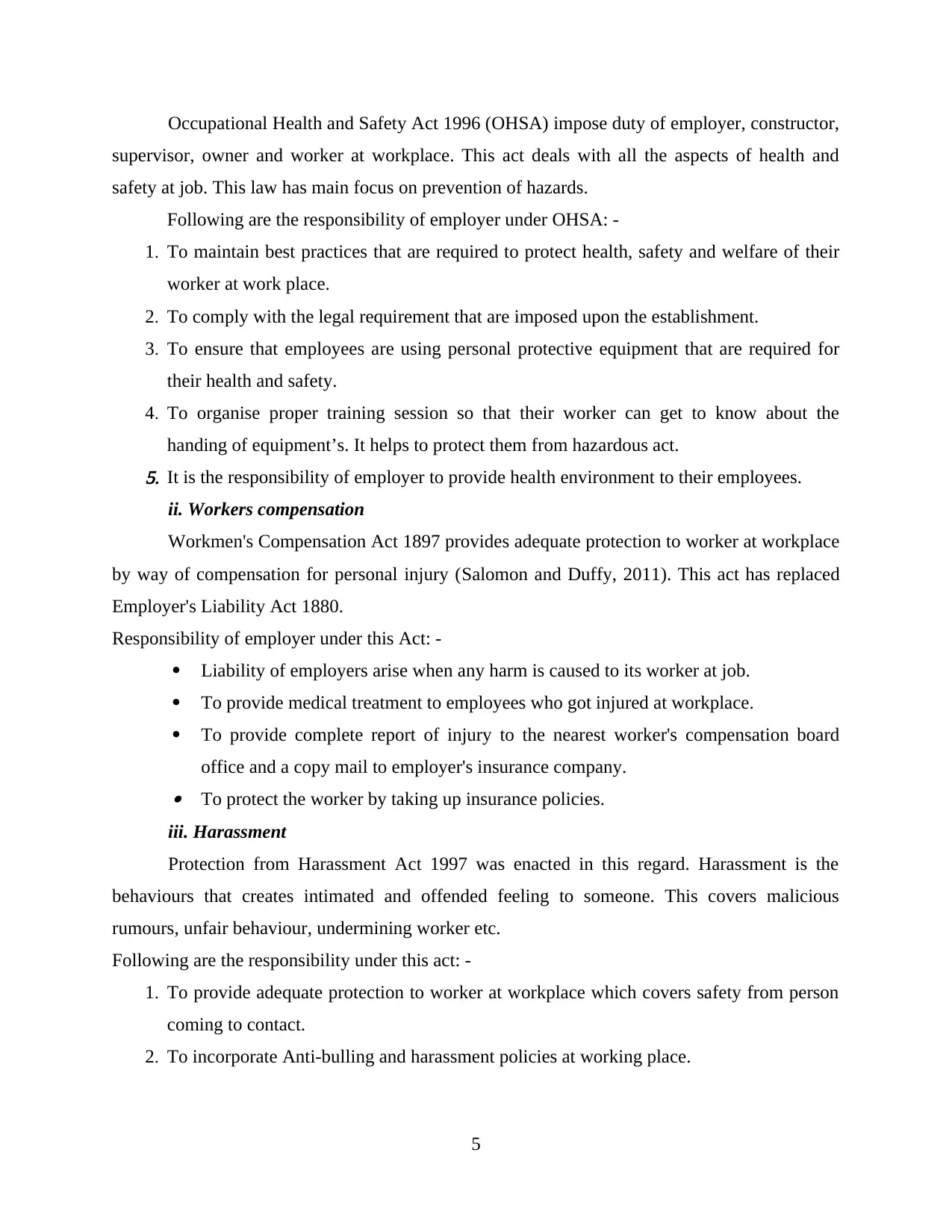
Occupational Health and Safety Act 1996 (OHSA) impose duty of employer, constructor,
supervisor, owner and worker at workplace. This act deals with all the aspects of health and
safety at job. This law has main focus on prevention of hazards.
Following are the responsibility of employer under OHSA: -
1. To maintain best practices that are required to protect health, safety and welfare of their
worker at work place.
2. To comply with the legal requirement that are imposed upon the establishment.
3. To ensure that employees are using personal protective equipment that are required for
their health and safety.
4. To organise proper training session so that their worker can get to know about the
handing of equipment’s. It helps to protect them from hazardous act.5. It is the responsibility of employer to provide health environment to their employees.
ii. Workers compensation
Workmen's Compensation Act 1897 provides adequate protection to worker at workplace
by way of compensation for personal injury (Salomon and Duffy, 2011). This act has replaced
Employer's Liability Act 1880.
Responsibility of employer under this Act: -
Liability of employers arise when any harm is caused to its worker at job.
To provide medical treatment to employees who got injured at workplace.
To provide complete report of injury to the nearest worker's compensation board
office and a copy mail to employer's insurance company.
To protect the worker by taking up insurance policies.
iii. Harassment
Protection from Harassment Act 1997 was enacted in this regard. Harassment is the
behaviours that creates intimated and offended feeling to someone. This covers malicious
rumours, unfair behaviour, undermining worker etc.
Following are the responsibility under this act: -
1. To provide adequate protection to worker at workplace which covers safety from person
coming to contact.
2. To incorporate Anti-bulling and harassment policies at working place.
5
supervisor, owner and worker at workplace. This act deals with all the aspects of health and
safety at job. This law has main focus on prevention of hazards.
Following are the responsibility of employer under OHSA: -
1. To maintain best practices that are required to protect health, safety and welfare of their
worker at work place.
2. To comply with the legal requirement that are imposed upon the establishment.
3. To ensure that employees are using personal protective equipment that are required for
their health and safety.
4. To organise proper training session so that their worker can get to know about the
handing of equipment’s. It helps to protect them from hazardous act.5. It is the responsibility of employer to provide health environment to their employees.
ii. Workers compensation
Workmen's Compensation Act 1897 provides adequate protection to worker at workplace
by way of compensation for personal injury (Salomon and Duffy, 2011). This act has replaced
Employer's Liability Act 1880.
Responsibility of employer under this Act: -
Liability of employers arise when any harm is caused to its worker at job.
To provide medical treatment to employees who got injured at workplace.
To provide complete report of injury to the nearest worker's compensation board
office and a copy mail to employer's insurance company.
To protect the worker by taking up insurance policies.
iii. Harassment
Protection from Harassment Act 1997 was enacted in this regard. Harassment is the
behaviours that creates intimated and offended feeling to someone. This covers malicious
rumours, unfair behaviour, undermining worker etc.
Following are the responsibility under this act: -
1. To provide adequate protection to worker at workplace which covers safety from person
coming to contact.
2. To incorporate Anti-bulling and harassment policies at working place.
5
Paraphrase This Document
Need a fresh take? Get an instant paraphrase of this document with our AI Paraphraser
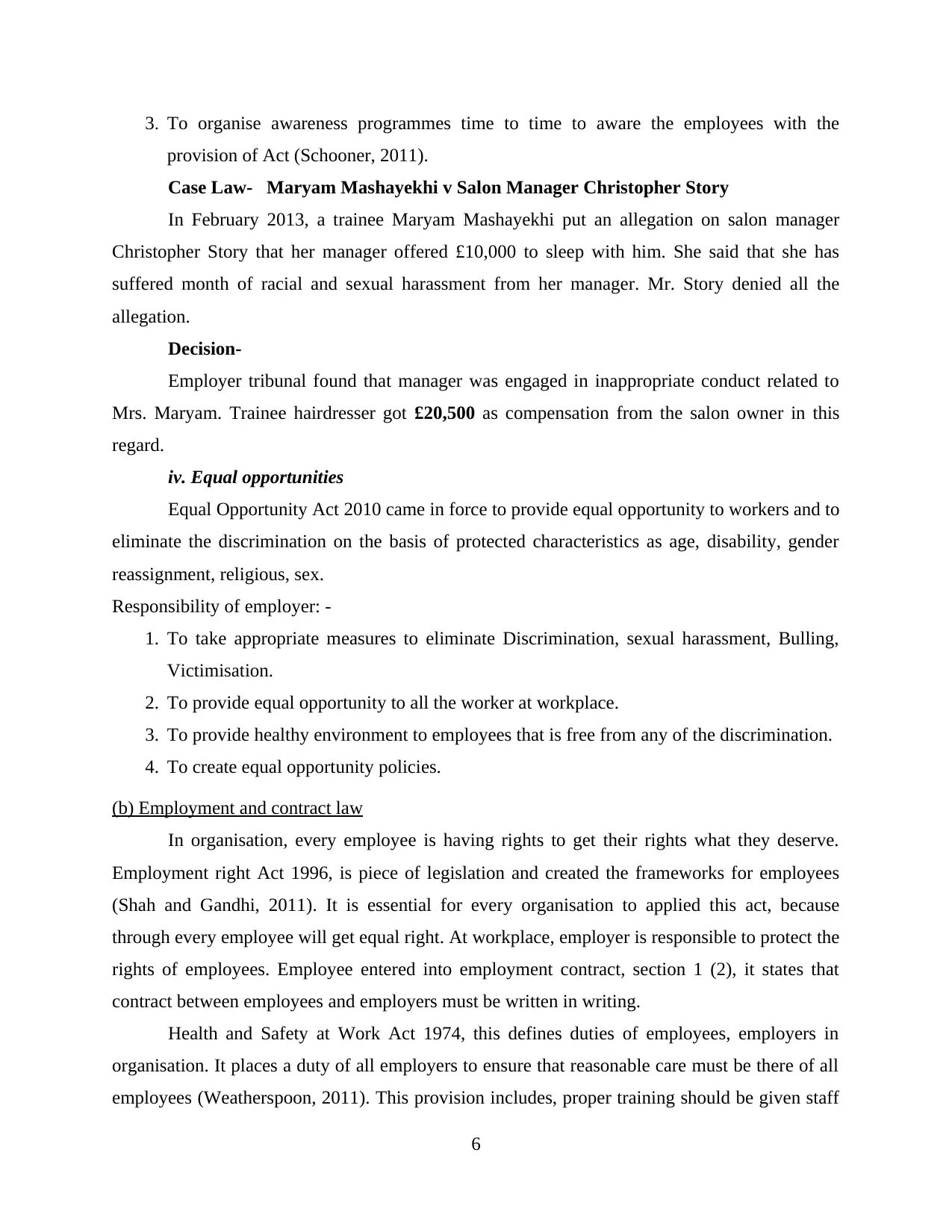
3. To organise awareness programmes time to time to aware the employees with the
provision of Act (Schooner, 2011).
Case Law- Maryam Mashayekhi v Salon Manager Christopher Story
In February 2013, a trainee Maryam Mashayekhi put an allegation on salon manager
Christopher Story that her manager offered £10,000 to sleep with him. She said that she has
suffered month of racial and sexual harassment from her manager. Mr. Story denied all the
allegation.
Decision-
Employer tribunal found that manager was engaged in inappropriate conduct related to
Mrs. Maryam. Trainee hairdresser got £20,500 as compensation from the salon owner in this
regard.
iv. Equal opportunities
Equal Opportunity Act 2010 came in force to provide equal opportunity to workers and to
eliminate the discrimination on the basis of protected characteristics as age, disability, gender
reassignment, religious, sex.
Responsibility of employer: -
1. To take appropriate measures to eliminate Discrimination, sexual harassment, Bulling,
Victimisation.
2. To provide equal opportunity to all the worker at workplace.
3. To provide healthy environment to employees that is free from any of the discrimination.
4. To create equal opportunity policies.
(b) Employment and contract law
In organisation, every employee is having rights to get their rights what they deserve.
Employment right Act 1996, is piece of legislation and created the frameworks for employees
(Shah and Gandhi, 2011). It is essential for every organisation to applied this act, because
through every employee will get equal right. At workplace, employer is responsible to protect the
rights of employees. Employee entered into employment contract, section 1 (2), it states that
contract between employees and employers must be written in writing.
Health and Safety at Work Act 1974, this defines duties of employees, employers in
organisation. It places a duty of all employers to ensure that reasonable care must be there of all
employees (Weatherspoon, 2011). This provision includes, proper training should be given staff
6
provision of Act (Schooner, 2011).
Case Law- Maryam Mashayekhi v Salon Manager Christopher Story
In February 2013, a trainee Maryam Mashayekhi put an allegation on salon manager
Christopher Story that her manager offered £10,000 to sleep with him. She said that she has
suffered month of racial and sexual harassment from her manager. Mr. Story denied all the
allegation.
Decision-
Employer tribunal found that manager was engaged in inappropriate conduct related to
Mrs. Maryam. Trainee hairdresser got £20,500 as compensation from the salon owner in this
regard.
iv. Equal opportunities
Equal Opportunity Act 2010 came in force to provide equal opportunity to workers and to
eliminate the discrimination on the basis of protected characteristics as age, disability, gender
reassignment, religious, sex.
Responsibility of employer: -
1. To take appropriate measures to eliminate Discrimination, sexual harassment, Bulling,
Victimisation.
2. To provide equal opportunity to all the worker at workplace.
3. To provide healthy environment to employees that is free from any of the discrimination.
4. To create equal opportunity policies.
(b) Employment and contract law
In organisation, every employee is having rights to get their rights what they deserve.
Employment right Act 1996, is piece of legislation and created the frameworks for employees
(Shah and Gandhi, 2011). It is essential for every organisation to applied this act, because
through every employee will get equal right. At workplace, employer is responsible to protect the
rights of employees. Employee entered into employment contract, section 1 (2), it states that
contract between employees and employers must be written in writing.
Health and Safety at Work Act 1974, this defines duties of employees, employers in
organisation. It places a duty of all employers to ensure that reasonable care must be there of all
employees (Weatherspoon, 2011). This provision includes, proper training should be given staff
6
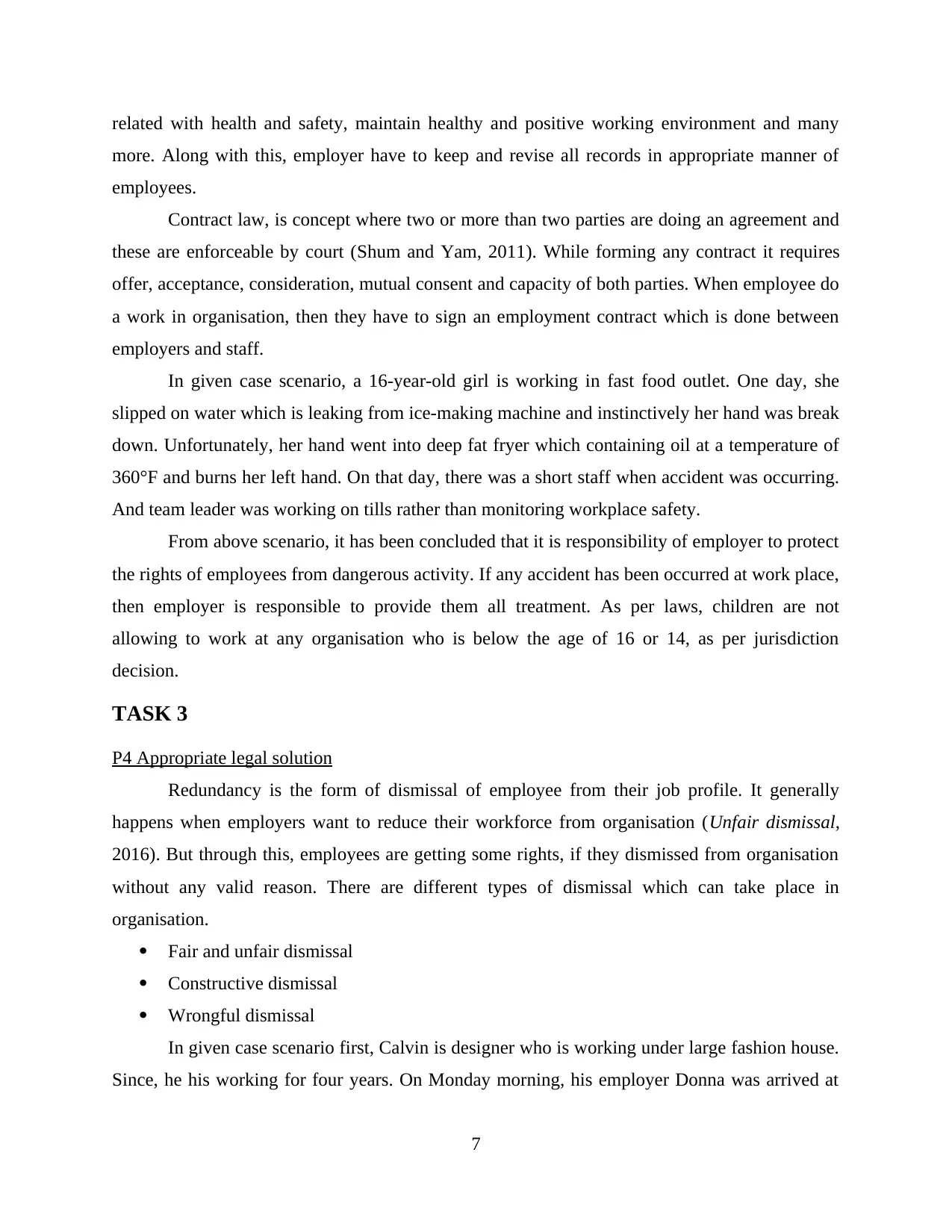
related with health and safety, maintain healthy and positive working environment and many
more. Along with this, employer have to keep and revise all records in appropriate manner of
employees.
Contract law, is concept where two or more than two parties are doing an agreement and
these are enforceable by court (Shum and Yam, 2011). While forming any contract it requires
offer, acceptance, consideration, mutual consent and capacity of both parties. When employee do
a work in organisation, then they have to sign an employment contract which is done between
employers and staff.
In given case scenario, a 16-year-old girl is working in fast food outlet. One day, she
slipped on water which is leaking from ice-making machine and instinctively her hand was break
down. Unfortunately, her hand went into deep fat fryer which containing oil at a temperature of
360°F and burns her left hand. On that day, there was a short staff when accident was occurring.
And team leader was working on tills rather than monitoring workplace safety.
From above scenario, it has been concluded that it is responsibility of employer to protect
the rights of employees from dangerous activity. If any accident has been occurred at work place,
then employer is responsible to provide them all treatment. As per laws, children are not
allowing to work at any organisation who is below the age of 16 or 14, as per jurisdiction
decision.
TASK 3
P4 Appropriate legal solution
Redundancy is the form of dismissal of employee from their job profile. It generally
happens when employers want to reduce their workforce from organisation (Unfair dismissal,
2016). But through this, employees are getting some rights, if they dismissed from organisation
without any valid reason. There are different types of dismissal which can take place in
organisation.
Fair and unfair dismissal
Constructive dismissal
Wrongful dismissal
In given case scenario first, Calvin is designer who is working under large fashion house.
Since, he his working for four years. On Monday morning, his employer Donna was arrived at
7
more. Along with this, employer have to keep and revise all records in appropriate manner of
employees.
Contract law, is concept where two or more than two parties are doing an agreement and
these are enforceable by court (Shum and Yam, 2011). While forming any contract it requires
offer, acceptance, consideration, mutual consent and capacity of both parties. When employee do
a work in organisation, then they have to sign an employment contract which is done between
employers and staff.
In given case scenario, a 16-year-old girl is working in fast food outlet. One day, she
slipped on water which is leaking from ice-making machine and instinctively her hand was break
down. Unfortunately, her hand went into deep fat fryer which containing oil at a temperature of
360°F and burns her left hand. On that day, there was a short staff when accident was occurring.
And team leader was working on tills rather than monitoring workplace safety.
From above scenario, it has been concluded that it is responsibility of employer to protect
the rights of employees from dangerous activity. If any accident has been occurred at work place,
then employer is responsible to provide them all treatment. As per laws, children are not
allowing to work at any organisation who is below the age of 16 or 14, as per jurisdiction
decision.
TASK 3
P4 Appropriate legal solution
Redundancy is the form of dismissal of employee from their job profile. It generally
happens when employers want to reduce their workforce from organisation (Unfair dismissal,
2016). But through this, employees are getting some rights, if they dismissed from organisation
without any valid reason. There are different types of dismissal which can take place in
organisation.
Fair and unfair dismissal
Constructive dismissal
Wrongful dismissal
In given case scenario first, Calvin is designer who is working under large fashion house.
Since, he his working for four years. On Monday morning, his employer Donna was arrived at
7
⊘ This is a preview!⊘
Do you want full access?
Subscribe today to unlock all pages.

Trusted by 1+ million students worldwide
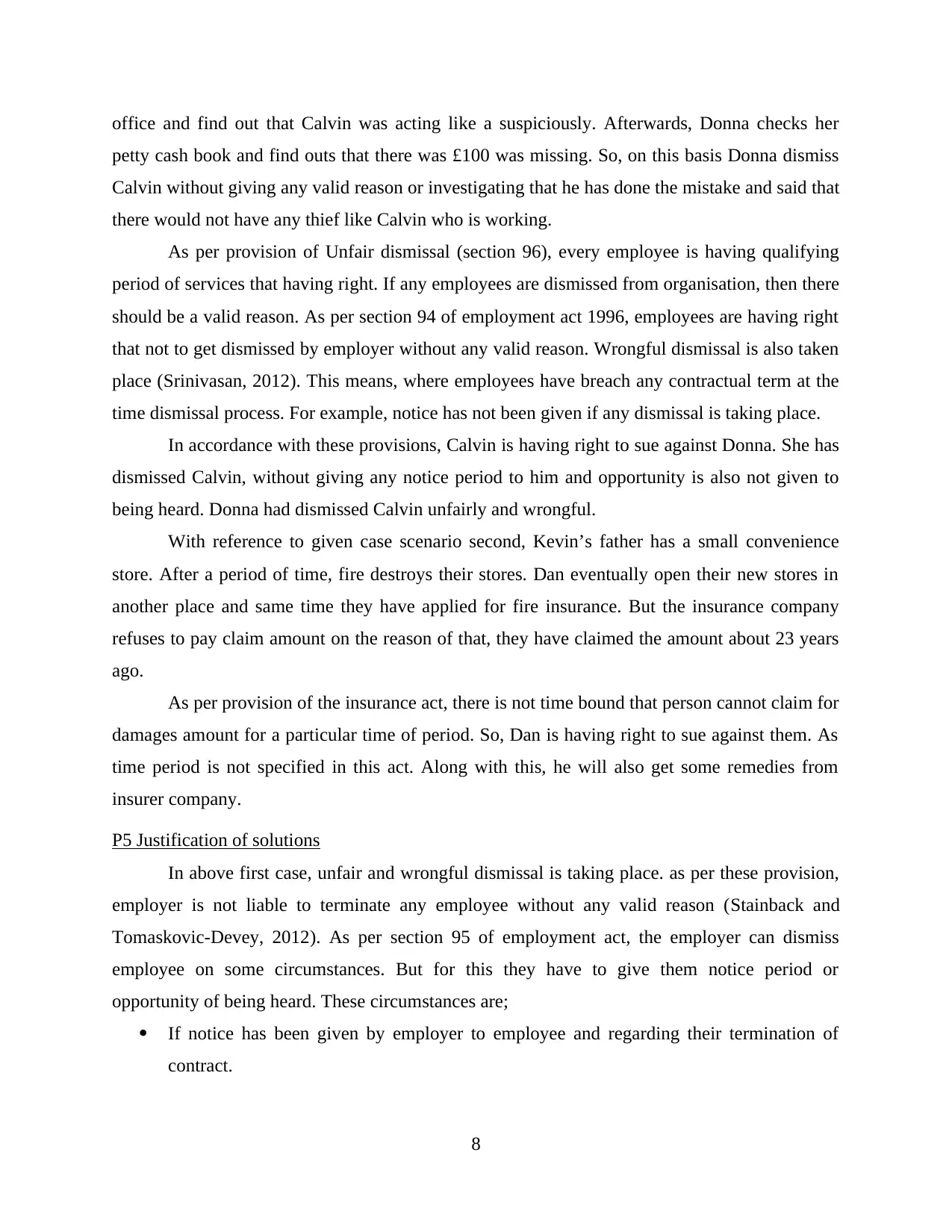
office and find out that Calvin was acting like a suspiciously. Afterwards, Donna checks her
petty cash book and find outs that there was £100 was missing. So, on this basis Donna dismiss
Calvin without giving any valid reason or investigating that he has done the mistake and said that
there would not have any thief like Calvin who is working.
As per provision of Unfair dismissal (section 96), every employee is having qualifying
period of services that having right. If any employees are dismissed from organisation, then there
should be a valid reason. As per section 94 of employment act 1996, employees are having right
that not to get dismissed by employer without any valid reason. Wrongful dismissal is also taken
place (Srinivasan, 2012). This means, where employees have breach any contractual term at the
time dismissal process. For example, notice has not been given if any dismissal is taking place.
In accordance with these provisions, Calvin is having right to sue against Donna. She has
dismissed Calvin, without giving any notice period to him and opportunity is also not given to
being heard. Donna had dismissed Calvin unfairly and wrongful.
With reference to given case scenario second, Kevin’s father has a small convenience
store. After a period of time, fire destroys their stores. Dan eventually open their new stores in
another place and same time they have applied for fire insurance. But the insurance company
refuses to pay claim amount on the reason of that, they have claimed the amount about 23 years
ago.
As per provision of the insurance act, there is not time bound that person cannot claim for
damages amount for a particular time of period. So, Dan is having right to sue against them. As
time period is not specified in this act. Along with this, he will also get some remedies from
insurer company.
P5 Justification of solutions
In above first case, unfair and wrongful dismissal is taking place. as per these provision,
employer is not liable to terminate any employee without any valid reason (Stainback and
Tomaskovic-Devey, 2012). As per section 95 of employment act, the employer can dismiss
employee on some circumstances. But for this they have to give them notice period or
opportunity of being heard. These circumstances are;
If notice has been given by employer to employee and regarding their termination of
contract.
8
petty cash book and find outs that there was £100 was missing. So, on this basis Donna dismiss
Calvin without giving any valid reason or investigating that he has done the mistake and said that
there would not have any thief like Calvin who is working.
As per provision of Unfair dismissal (section 96), every employee is having qualifying
period of services that having right. If any employees are dismissed from organisation, then there
should be a valid reason. As per section 94 of employment act 1996, employees are having right
that not to get dismissed by employer without any valid reason. Wrongful dismissal is also taken
place (Srinivasan, 2012). This means, where employees have breach any contractual term at the
time dismissal process. For example, notice has not been given if any dismissal is taking place.
In accordance with these provisions, Calvin is having right to sue against Donna. She has
dismissed Calvin, without giving any notice period to him and opportunity is also not given to
being heard. Donna had dismissed Calvin unfairly and wrongful.
With reference to given case scenario second, Kevin’s father has a small convenience
store. After a period of time, fire destroys their stores. Dan eventually open their new stores in
another place and same time they have applied for fire insurance. But the insurance company
refuses to pay claim amount on the reason of that, they have claimed the amount about 23 years
ago.
As per provision of the insurance act, there is not time bound that person cannot claim for
damages amount for a particular time of period. So, Dan is having right to sue against them. As
time period is not specified in this act. Along with this, he will also get some remedies from
insurer company.
P5 Justification of solutions
In above first case, unfair and wrongful dismissal is taking place. as per these provision,
employer is not liable to terminate any employee without any valid reason (Stainback and
Tomaskovic-Devey, 2012). As per section 95 of employment act, the employer can dismiss
employee on some circumstances. But for this they have to give them notice period or
opportunity of being heard. These circumstances are;
If notice has been given by employer to employee and regarding their termination of
contract.
8
Paraphrase This Document
Need a fresh take? Get an instant paraphrase of this document with our AI Paraphraser
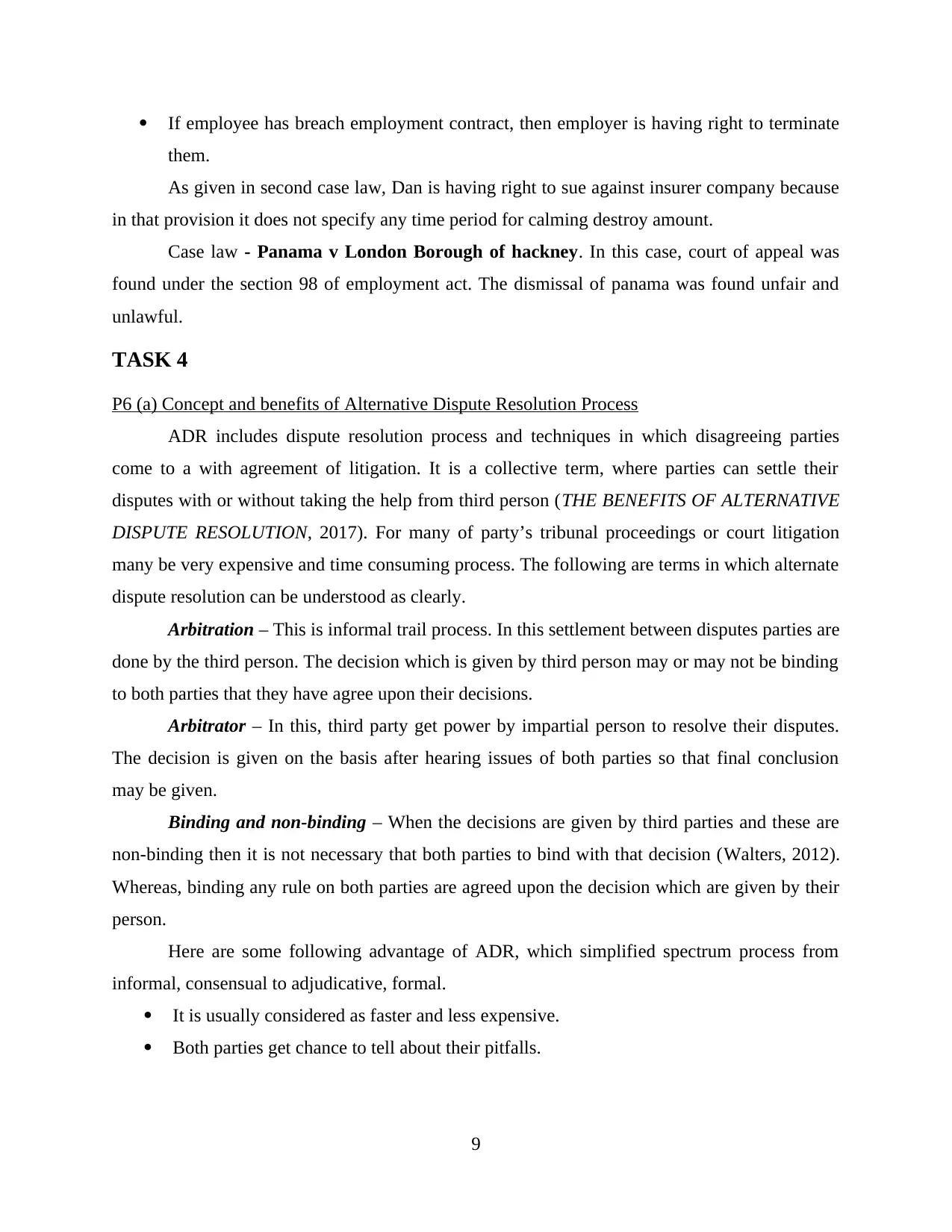
If employee has breach employment contract, then employer is having right to terminate
them.
As given in second case law, Dan is having right to sue against insurer company because
in that provision it does not specify any time period for calming destroy amount.
Case law - Panama v London Borough of hackney. In this case, court of appeal was
found under the section 98 of employment act. The dismissal of panama was found unfair and
unlawful.
TASK 4
P6 (a) Concept and benefits of Alternative Dispute Resolution Process
ADR includes dispute resolution process and techniques in which disagreeing parties
come to a with agreement of litigation. It is a collective term, where parties can settle their
disputes with or without taking the help from third person (THE BENEFITS OF ALTERNATIVE
DISPUTE RESOLUTION, 2017). For many of party’s tribunal proceedings or court litigation
many be very expensive and time consuming process. The following are terms in which alternate
dispute resolution can be understood as clearly.
Arbitration – This is informal trail process. In this settlement between disputes parties are
done by the third person. The decision which is given by third person may or may not be binding
to both parties that they have agree upon their decisions.
Arbitrator – In this, third party get power by impartial person to resolve their disputes.
The decision is given on the basis after hearing issues of both parties so that final conclusion
may be given.
Binding and non-binding – When the decisions are given by third parties and these are
non-binding then it is not necessary that both parties to bind with that decision (Walters, 2012).
Whereas, binding any rule on both parties are agreed upon the decision which are given by their
person.
Here are some following advantage of ADR, which simplified spectrum process from
informal, consensual to adjudicative, formal.
It is usually considered as faster and less expensive.
Both parties get chance to tell about their pitfalls.
9
them.
As given in second case law, Dan is having right to sue against insurer company because
in that provision it does not specify any time period for calming destroy amount.
Case law - Panama v London Borough of hackney. In this case, court of appeal was
found under the section 98 of employment act. The dismissal of panama was found unfair and
unlawful.
TASK 4
P6 (a) Concept and benefits of Alternative Dispute Resolution Process
ADR includes dispute resolution process and techniques in which disagreeing parties
come to a with agreement of litigation. It is a collective term, where parties can settle their
disputes with or without taking the help from third person (THE BENEFITS OF ALTERNATIVE
DISPUTE RESOLUTION, 2017). For many of party’s tribunal proceedings or court litigation
many be very expensive and time consuming process. The following are terms in which alternate
dispute resolution can be understood as clearly.
Arbitration – This is informal trail process. In this settlement between disputes parties are
done by the third person. The decision which is given by third person may or may not be binding
to both parties that they have agree upon their decisions.
Arbitrator – In this, third party get power by impartial person to resolve their disputes.
The decision is given on the basis after hearing issues of both parties so that final conclusion
may be given.
Binding and non-binding – When the decisions are given by third parties and these are
non-binding then it is not necessary that both parties to bind with that decision (Walters, 2012).
Whereas, binding any rule on both parties are agreed upon the decision which are given by their
person.
Here are some following advantage of ADR, which simplified spectrum process from
informal, consensual to adjudicative, formal.
It is usually considered as faster and less expensive.
Both parties get chance to tell about their pitfalls.
9
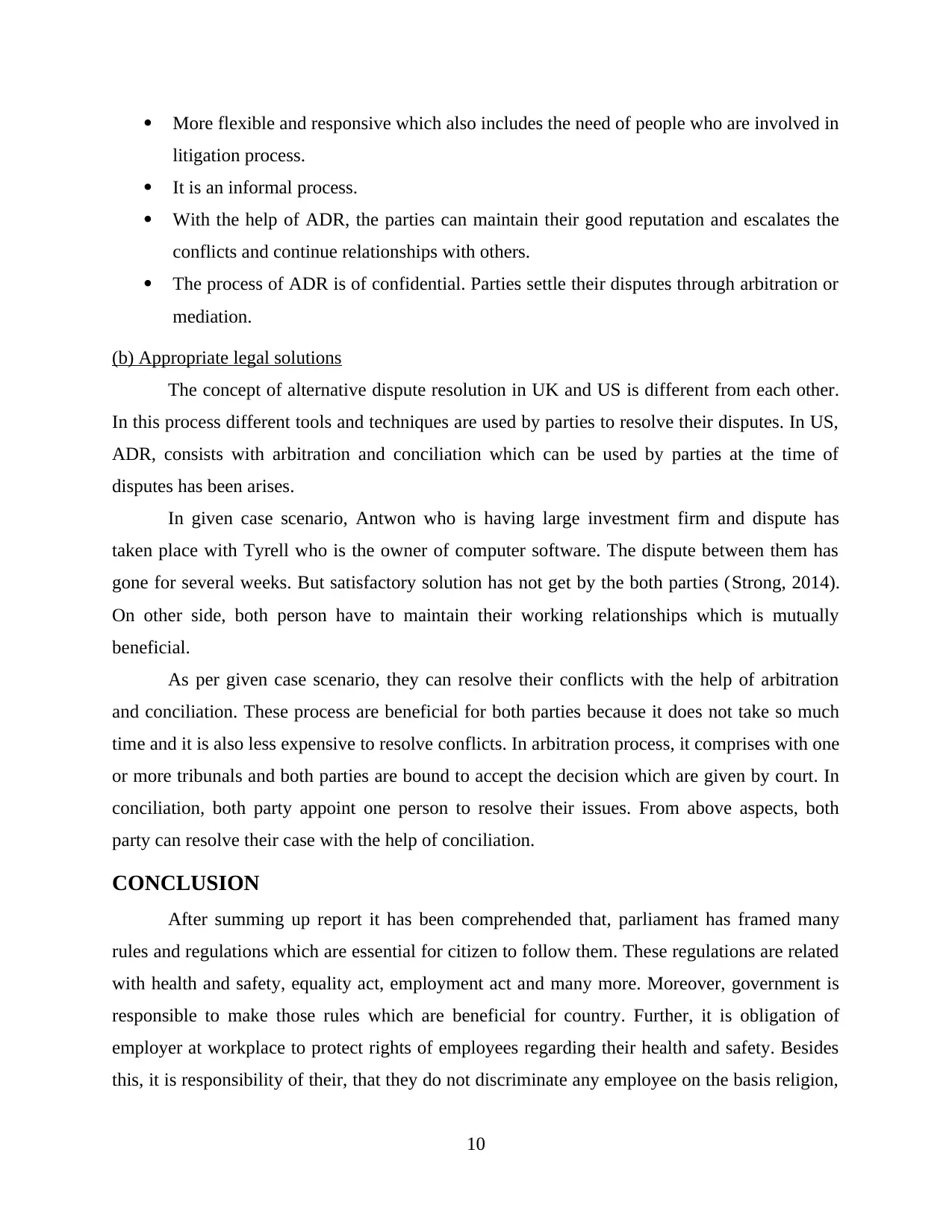
More flexible and responsive which also includes the need of people who are involved in
litigation process.
It is an informal process.
With the help of ADR, the parties can maintain their good reputation and escalates the
conflicts and continue relationships with others.
The process of ADR is of confidential. Parties settle their disputes through arbitration or
mediation.
(b) Appropriate legal solutions
The concept of alternative dispute resolution in UK and US is different from each other.
In this process different tools and techniques are used by parties to resolve their disputes. In US,
ADR, consists with arbitration and conciliation which can be used by parties at the time of
disputes has been arises.
In given case scenario, Antwon who is having large investment firm and dispute has
taken place with Tyrell who is the owner of computer software. The dispute between them has
gone for several weeks. But satisfactory solution has not get by the both parties (Strong, 2014).
On other side, both person have to maintain their working relationships which is mutually
beneficial.
As per given case scenario, they can resolve their conflicts with the help of arbitration
and conciliation. These process are beneficial for both parties because it does not take so much
time and it is also less expensive to resolve conflicts. In arbitration process, it comprises with one
or more tribunals and both parties are bound to accept the decision which are given by court. In
conciliation, both party appoint one person to resolve their issues. From above aspects, both
party can resolve their case with the help of conciliation.
CONCLUSION
After summing up report it has been comprehended that, parliament has framed many
rules and regulations which are essential for citizen to follow them. These regulations are related
with health and safety, equality act, employment act and many more. Moreover, government is
responsible to make those rules which are beneficial for country. Further, it is obligation of
employer at workplace to protect rights of employees regarding their health and safety. Besides
this, it is responsibility of their, that they do not discriminate any employee on the basis religion,
10
litigation process.
It is an informal process.
With the help of ADR, the parties can maintain their good reputation and escalates the
conflicts and continue relationships with others.
The process of ADR is of confidential. Parties settle their disputes through arbitration or
mediation.
(b) Appropriate legal solutions
The concept of alternative dispute resolution in UK and US is different from each other.
In this process different tools and techniques are used by parties to resolve their disputes. In US,
ADR, consists with arbitration and conciliation which can be used by parties at the time of
disputes has been arises.
In given case scenario, Antwon who is having large investment firm and dispute has
taken place with Tyrell who is the owner of computer software. The dispute between them has
gone for several weeks. But satisfactory solution has not get by the both parties (Strong, 2014).
On other side, both person have to maintain their working relationships which is mutually
beneficial.
As per given case scenario, they can resolve their conflicts with the help of arbitration
and conciliation. These process are beneficial for both parties because it does not take so much
time and it is also less expensive to resolve conflicts. In arbitration process, it comprises with one
or more tribunals and both parties are bound to accept the decision which are given by court. In
conciliation, both party appoint one person to resolve their issues. From above aspects, both
party can resolve their case with the help of conciliation.
CONCLUSION
After summing up report it has been comprehended that, parliament has framed many
rules and regulations which are essential for citizen to follow them. These regulations are related
with health and safety, equality act, employment act and many more. Moreover, government is
responsible to make those rules which are beneficial for country. Further, it is obligation of
employer at workplace to protect rights of employees regarding their health and safety. Besides
this, it is responsibility of their, that they do not discriminate any employee on the basis religion,
10
⊘ This is a preview!⊘
Do you want full access?
Subscribe today to unlock all pages.

Trusted by 1+ million students worldwide
1 out of 15
Related Documents
Your All-in-One AI-Powered Toolkit for Academic Success.
+13062052269
info@desklib.com
Available 24*7 on WhatsApp / Email
![[object Object]](/_next/static/media/star-bottom.7253800d.svg)
Unlock your academic potential
Copyright © 2020–2025 A2Z Services. All Rights Reserved. Developed and managed by ZUCOL.





